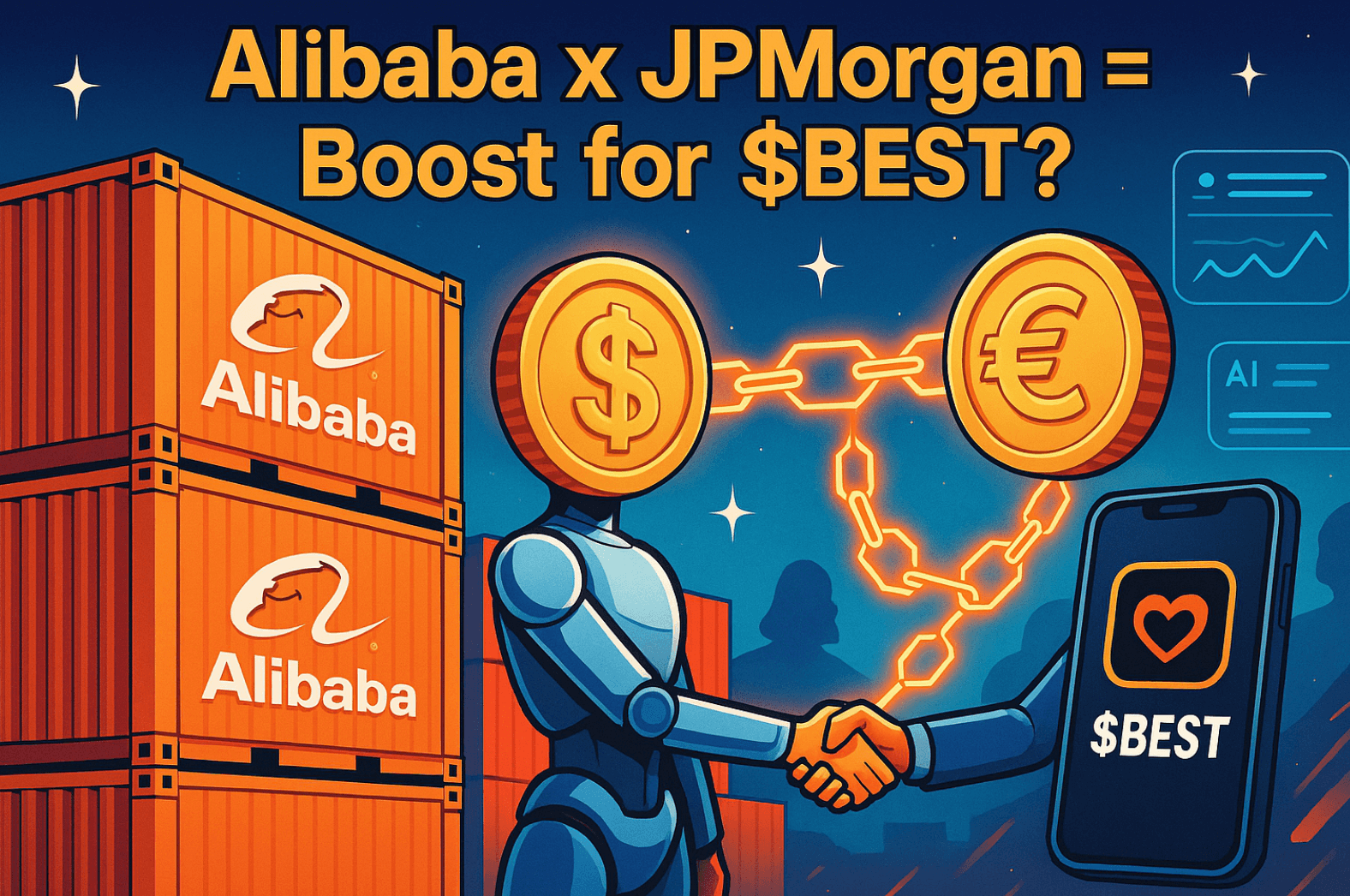What to Know:
- Alibaba and JPMorgan are rolling out tokenized deposit rails for global B2B payments, compressing transaction settlement times from days to near-instant.
- Deposit tokens keep money inside the banking perimeter while using blockchain for speed, putting more pressure on wallet infrastructure to handle multiple forms of digital cash.
- Best Wallet combines a non-custodial, multi-chain wallet with a DEX aggregator, presale launchpad and planned card and analytics stack inside one mobile app.
- Best Wallet Token lets holders tap into that ecosystem through lower fees, boosted staking yields and early deal flow rather than pure price speculation.
Alibaba’s global B2B arm is about to move serious money on-chain.
The company will plug into JPMorgan’s JPMD infrastructure and Kinexys tokenization stack to settle cross-border trade using tokenized deposits backed by fiat currencies like the US dollar and the euro.
These deposits behave a lot like stablecoins on the surface. But under the hood, they sit on regulated bank balance sheets.
That keeps regulators comfortable and gives Alibaba near-instant settlements for global buyers and suppliers who currently wait 2–3 days and pass through multiple correspondent banks for a single payment.
Alibaba plans to roll out its ‘Agentic Pay’ by December 2025. This will pair tokenized money with AI that can turn buyer–seller chats into executable smart contracts.
The first phase will use bank-issued digital tokens to keep things clean from a policy and compliance standpoint, especially given Beijing’s hard line on stablecoins.
For everyday users and smaller businesses, this shift has a simple implication. If big B2B platforms start settling value natively on-chain, wallets become the key interface to tokenized dollars, euros and everything in-between.
Non-custodial, multi-chain wallets that can route value between deposit tokens, stablecoins and DeFi will sit right in the flow of this new money.
That’s exactly the world Best Wallet is building for. And its in-app crypto wallet token, Best Wallet Token ($BEST), is designed to capture a share of that flow.
Read more about Best Wallet Token in our review.
Tokenized Deposits Put Wallet Infrastructure In The Spotlight
Alibaba and JPMorgan are not experimenting with a meme coin.
They’re wiring real-world payments where tokenized bank money moves across borders on a permissioned blockchain. All while plugging into familiar banking compliance checks.

Deposit tokens effectively give institutions the UX of stablecoins without stepping outside the banking perimeter. That model is likely to spread because global trade runs on razor-thin margins and brutal settlement frictions.
If one of the largest B2B platforms proves that a deposit-token rail can deliver near-instant settlement, lower FX and correspondent costs, and better transparency, competitors are not going to sit on the sidelines.
In that environment, the ‘front end’ that users actually touch is the wallet, not the bank core.
That’s where retail infrastructure meets institutional solutions. Tokenized deposits will mostly live in compliant, bank-linked environments. But users still need tools to route value into stablecoins, L2s, DeFi strategies and even early-stage token sales.
Infrastructure that only does one chain, or only handles basic send-and-receive flows, starts to look dated fast.
Its whitepaper sets an aggressive goal: capture 40% of the crypto wallet market by the end of 2026, using Fireblocks MPC tech, a presale launchpad, and upcoming features like MEV protection, advanced order types and market analytics.
If tokenized bank money becomes the norm for large-ticket payments, flexible wallets that can speak both ‘TradFi token’ and ‘DeFi native’ stand to win the most volume.
Best Wallet is positioning itself as that hub, and the $BEST token is the mechanism that lets users share in the wallet’s growth through lower fees, boosted yields and governance.
Here’s why.
Best Wallet Token Turns A Non-Custodial App Into An Asset
The Best Wallet Token ($BEST) token is wired directly into the wallet’s economics. Holding and staking $BEST unlocks reduced swap and card fees.
It also unlocks higher staking rewards through an upcoming staking aggregator, priority access to some of the best crypto presales, governance rights, and boosted cashback on the forthcoming Best Card.
Staking is live during the presale, with dynamic rewards currently around 76% APY for early participants, funded from a dedicated 8% allocation of the total 10B token supply.

🤑 Here’s how to buy $BEST before the presale ends.
Our Best Wallet Token price prediction places potential 2026 highs for $BEST at $0.05106175 or an ~100% upside , depending on how the presale closes, how quickly listings roll out and how strong the next altcoin rotation is.
Crucially, those numbers are tied to real wallet usage, not just hype.
Best Wallet already runs on Ethereum and is built to plug directly into the kind of regulated, tokenized rails Alibaba is helping normalize. It also gives users self-custody, no mandatory KYC in-app, and Fireblocks-grade security.
For traders and long-term holders alike, $BEST effectively tokenizes that wallet business model. It’s a must-watch for anyone building a diversified bag around the emerging tokenized-payments narrative lit up by Alibaba and JPMorgan.
Consider accumulating $BEST before listings.
This article is informational only, not financial advice. Crypto assets are volatile and speculative; always do independent research before investing.
Authored by Aaron Walker, NewsBTC – https://www.newsbtc.com/news/alibaba-jpmorgan-blockchain–tokenization-best-wallet-token-benefits
